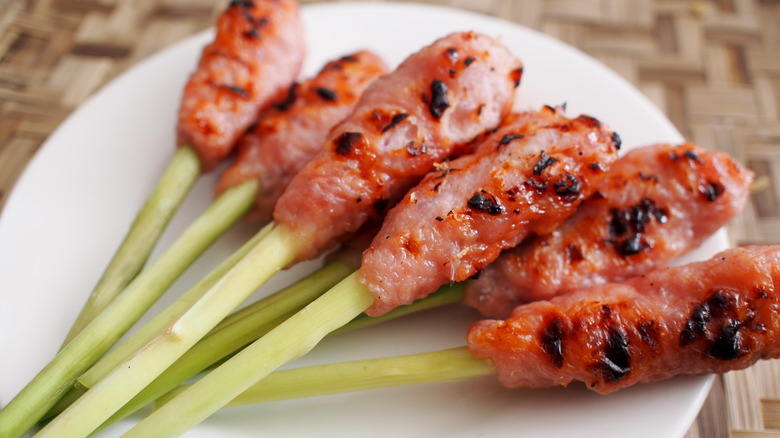Why You Should Be Cooking With Lemongrass More Often
Herbs and aromatics can be essential ingredients when trying to put your own signature spin on a recipe. One ingredient that you might want to consider using in this quest is lemongrass. Per Food Roots, lemongrass is a fragrant, grass-like herb with many health benefits. While it may have its roots in warmer Asian and Indian regions of the world, it can also be found at specialty markets and just about any local grocery store. At first glance, it might be mistaken for a green onion, but it's actually a little lighter in color and has a rougher stalk (via MasterClass).
Lemongrass can leave a new cook feeling a little overwhelmed and wondering if it is worth the challenge of incorporating it into your recipes. If you poke around on Google, most articles concede lemongrass is an "intimidating" herb, but one you definitely want to have in your kitchen arsenal. According to MasterClass, lemongrass has a citrusy profile that is commonly used to balance some of the heavier flavors in many Asian dishes.
If you are a fan of Vietnamese or Thai food, chances are that you've experienced its flavor in a dish or two. It is also used frequently as both aromatherapy and a dietary supplement for a wide range of health concerns (via Healthline). It has antioxidant, antimicrobial, and anti-inflammatory properties, making it a beneficial addition to many dishes and drinks.
To cook with lemongrass, prep is essential
According to MasterClass, lemongrass is more than just an aromatic; it's quite versatile. It adds a light flavor and incorporates hints of ginger and citrusy-floral notes to an array of dishes. Lemongrass can also provide a uniquely minty element to recipes and is great to use for dishes that include chicken, Vietnamese rice noodles, soup broth, or even in iced tea. If tofu or fish is your protein of choice, lemongrass may be useful when experimenting with how to pair new flavors.
If you are going to cook with lemongrass, prepping it correctly is critical. MasterClass instructs lemongrass users to peel away those "paper-like" husks until they hit the center, which is soft and white in appearance. If you want to make full use of the lemongrass stalks as well, they are perfect for making tea or broth. It's recommended that you "bruise" the stalk by smashing it with your knife to liberate the oils before incorporating it. However, once you've achieved your desired flavor, you can fish out the stalks and throw them away.
You can even crush the extra lemongrass and turn it into a paste, according to Martha Stewart, who adds shallots, ginger, and garlic to her lemongrass paste to create a real aromatic firework. Unfortunately, the paste is only fresh for around two days in the fridge, but it's a great way to use up any you have left over after cooking.

